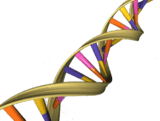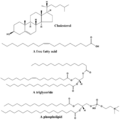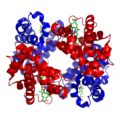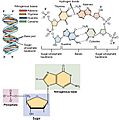Biochemistry facts for kids
Biochemistry is the study of chemical reactions in living beings, and of biological molecules in general. It is important to cell biology and physiology. The study of biochemistry involves enzymes, nucleic acids, carbohydrates, sugars, proteins, and lipids. In the body, most of the molecules are polymers built of long chains of smaller molecules. Biochemistry studies the chemical transformations which produce these small building-block molecules, and which produce energy from food.
Contents
Macromolecules
The biologic polymers can have between tens of thousands to tens of millions of atoms, or more. These polymers are composed of many small molecules, each of which has no more than fifty atoms. These small molecules are made almost exclusively from carbon, hydrogen, oxygen, and nitrogen. They also contain sulfur, phosphorus, and few other atoms, which are critical to the biological functioning of these polymers.
There are four types of macromolecules.
Nucleic Acids
Nucleic acids are long-chain molecules which are of two kinds: DNA and RNA. Their building blocks are called nucleotides.
DNA is found in every cell. It contains the information needed to make all of the nucleic acids, and all of the proteins. It is found joined up in a double helix. It is the substance of heredity, and holds the information which life passes from generation to generation.
RNA acts to make the information from DNA work inside the cells of the body. To make a particular protein the information in the DNA is transferred to an RNA molecule. Another RNA molecule uses this as a set of instructions for making the protein. The RNA which makes protein is called a ribosome and it acts as a ribozyme vastly increasing the speed with which the individual amino acids connect together to form the protein.
Proteins
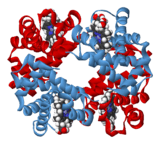
Proteins are polymers of amino acids. There are twenty different common types of amino acid.
Broadly speaking, proteins have two kinds of function. The first is structural: they make up many of the key structures in cells and tissues. Muscle, hair, and skin are all mainly made of protein. The second is functional: as enzymes they greatly speed up the chemical reactions in a living cell. All cellular life consists of a thousand, or more, chemical reactions, called metabolism, which transform the molecules eaten into energy, or into other molecules the cell needs to survive. The function of proteins is to speed up these reactions, often by over a million times faster. In addition they cause chemical reactions to occur which would not without the action of the protein.
Carbohydrates
Carbohydrates include sugars and starches.
Sugars are the simplest carbohydrates. The monosaccharides are "single sugars", such as glucose and fructose. The disaccharides are two monosaccharides joined together. Table sugar (cane sugar) is a disaccharide of glucose and fructose. The polysaccharides are made from many monosaccharids joined together. The vast majority of polysaccharides are polymers of glucose, and are of two types: starch and cellulose. Starch is the white stuff of grain, potatoes, apples, and bread, and is a readily available source of energy for the body. Cellulose is the structural material that holds up all plants. Half of the material that makes wood is cellulose.
Carbohydrates have a number of functions in the body, but the most important is to act as a ready source of energy for the cell's metabolism. By breaking the chemical bonds in carbohydrates, energy is released and can be used by the body.
Lipids
Lipids are fats, and waxes. Saturated lipids contain single bonds, and are found in butter and lard. Unsaturated lipids have one or more double bonds, and are often found in oils. The human body stores lipids as an energy source. When the body needs a large amount of energy, lipid molecules are broken down to release that energy.
Related pages
Images for kids
-
Gerty Cori and Carl Cori jointly won the Nobel Prize in 1947 for their discovery of the Cori cycle at RPMI.
-
Structures of some common lipids. At the top are cholesterol and oleic acid. The middle structure is a triglyceride composed of oleoyl, stearoyl, and palmitoyl chains attached to a glycerol backbone. At the bottom is the common phospholipid, phosphatidylcholine.
-
A schematic of hemoglobin. The red and blue ribbons represent the protein globin; the green structures are the heme groups.
-
Examples of protein structures from the Protein Data Bank
-
The structure of deoxyribonucleic acid (DNA), the picture shows the monomers being put together.
See also
 In Spanish: Bioquímica para niños
In Spanish: Bioquímica para niños


